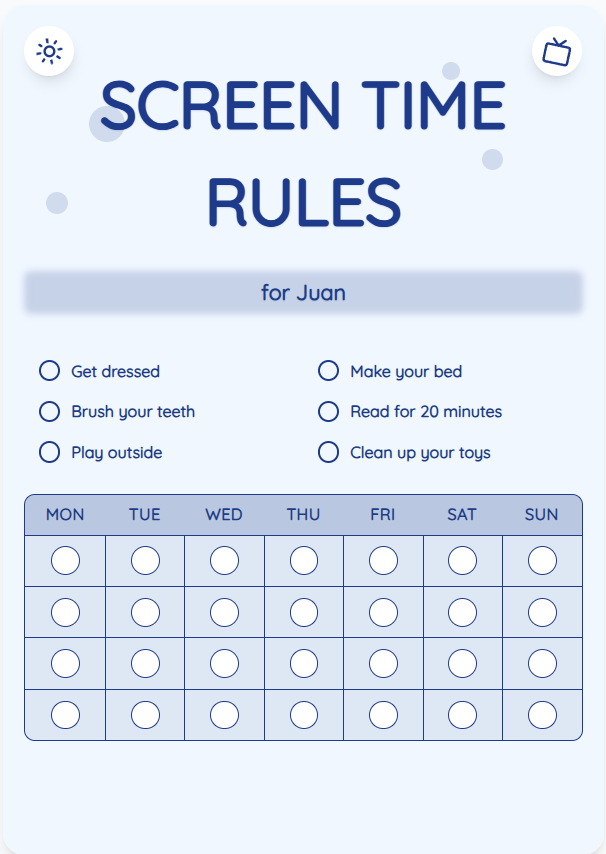Navigating Screen Time in 2025: Practical Tips for Parents
As we step into 2025, the digital landscape continues to evolve, presenting new challenges for parents in managing their children's screen time. Balancing the benefits and risks of technology is crucial for healthy child development and family harmony. Let's explore actionable strategies to guide you through the screen time maze of the future.
See What Your Screen Time Chart Will Look Like
Here's an example of a beautiful, customizable screen time rules chart you can create for your family

Understanding the Impact of Screen Time on Child Development
In this digital age, children are exposed to screens from an early age. Excessive screen time has been linked to various issues, including sleep disturbances, behavioral problems, and decreased physical activity. As a parent, it's essential to understand how screen time affects your child's development and well-being.
Setting Screen Time Limits: The Key to Healthy Tech Habits
Establishing clear screen time limits is crucial in managing your child's device usage. Create a screen time schedule that includes designated tech-free times and promotes alternative activities like outdoor play, reading, and family bonding. Consistency is key in fostering healthy tech habits.
Put These Tips Into Action
Create a custom chart to implement these strategies with your child
Creating a Family Screen Time Charter: A Collaborative Approach
Developing a family screen time charter allows you to involve your children in setting screen time rules. Together, establish guidelines on when, where, and how screens can be used. Encourage open communication and mutual respect to ensure a harmonious tech environment at home.
Practical Tips for Success
- Use screen time charts to visually represent and track your child's daily device usage.
- Encourage offline activities such as arts and crafts, sports, or imaginative play to reduce screen time.
- Lead by example by modeling healthy screen habits and limiting your own device use in front of your children.
- Utilize parental control features on devices to regulate and monitor your child's screen time.
Frequently Asked Questions
How much screen time is appropriate for my child in 2025?
The American Academy of Pediatrics recommends no more than 1 hour of high-quality screen time per day for children aged 2-5. For older children, aim for consistent limits that balance screen use with other activities.
How can I manage resistance when enforcing screen time limits?
Engage your child in conversations about the reasons behind screen time limits and involve them in creating a screen time schedule. Consistency, positive reinforcement, and setting clear consequences for exceeding limits can help manage resistance.
Are all types of screen time harmful for my child?
Not all screen time is created equal. Educational content, interactive apps, and supervised video calls can have benefits for children. It's important to monitor the quality of content and ensure a balanced mix of screen activities.
Navigating the evolving landscape of screen time in 2025 requires proactive parenting strategies that prioritize child development and family well-being. By implementing practical tips like using screen time charts and fostering open communication, you can create a healthy tech balance for your family. Visit ScreenTimeRules.com to access customizable screen time charts and start your journey towards a harmonious relationship with technology.
Ready to Transform Your Family's Screen Time?
Join thousands of parents who have successfully managed screen time with our customizable charts.
